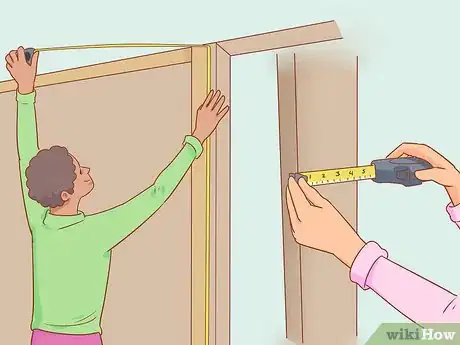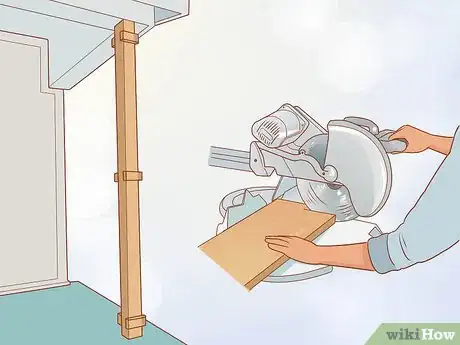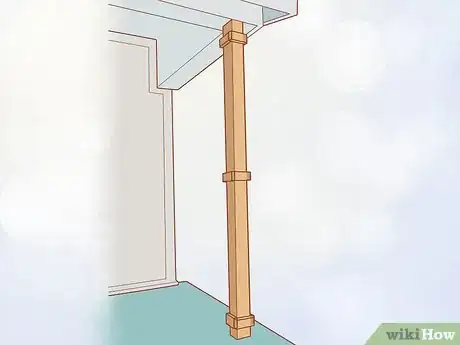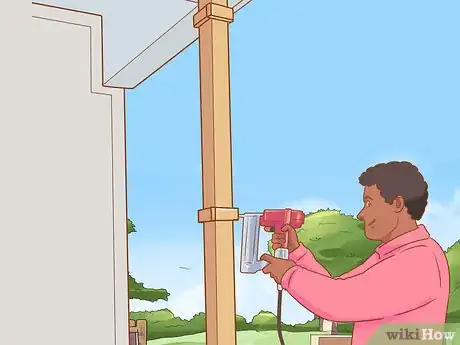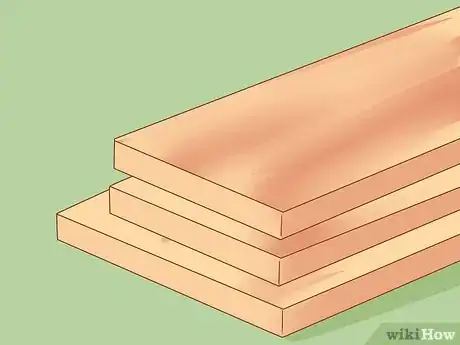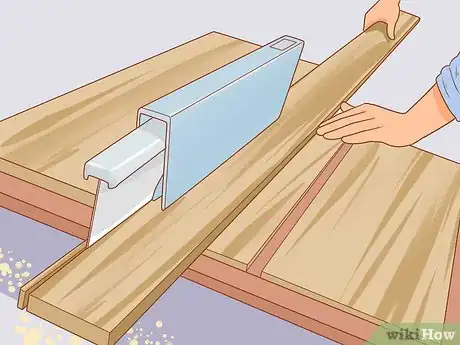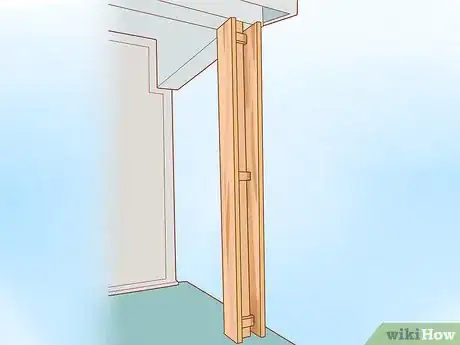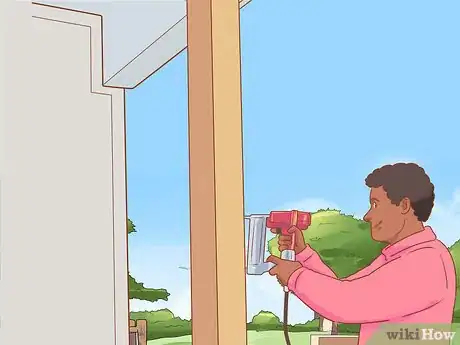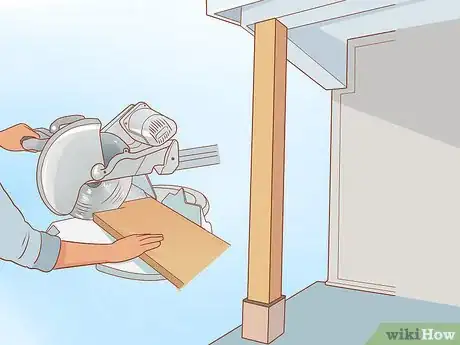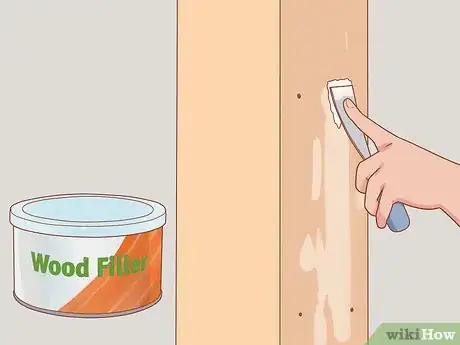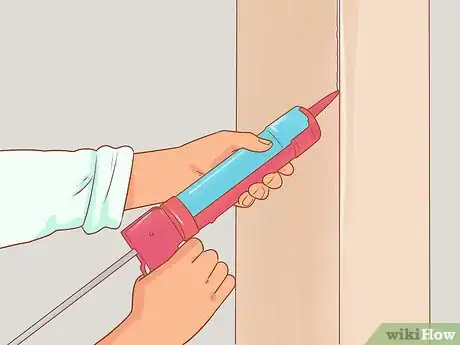This article was co-authored by wikiHow Staff. Our trained team of editors and researchers validate articles for accuracy and comprehensiveness. wikiHow's Content Management Team carefully monitors the work from our editorial staff to ensure that each article is backed by trusted research and meets our high quality standards.
There are 12 references cited in this article, which can be found at the bottom of the page.
This article has been viewed 51,178 times.
Learn more...
If you’re less than thrilled about your home’s plain-looking porch posts, wrapping them can be a quick and easy alternative to having new ones made. Wrapping porch posts is a simple DIY project that essentially involves constructing a boxlike facade around ordinary squares posts to build them up and give them a more impressive, stately appearance. When you’re done, you can add other visually-pleasing touches, like a new coat of paint or a few pieces of decorative molding, to make your upgraded posts even more ornate.
Steps
Adding Spacers to the Posts
-
1Measure the height and width of your porch posts. Stretch a tape measure from the floor of your porch up to the ceiling or bottom of the upper level deck alongside one of the posts. Then, extend it across the post from one vertical edge to the other. Jot down both dimensions on a separate sheet of paper. You’ll use them to cut the wooden panels for your new facades to the appropriate size.
- Record the dimensions of each of your posts separately. They should all be the same height and width, but there’s no guarantee that they are.
- Rarely, porch posts may be rectangular rather than square. If your porch posts are rectangular, be sure to note the dimensions of both the longer and shorter sides.[1]
-
2Cut 6 pieces of 1 in- (2.5 cm) thick wood to the width of your posts. Use a circular saw, miter saw, or portable table saw to trim a single long board into identical sections. The width of these pieces should correspond exactly to the width of your porch posts, while the height can be 1–2 inches (2.5–5.1 cm) longer than the width, depending on the exact dimensions of the posts. These pieces will serve as the first set of spacers for your facades—one piece for the left and right sides of the post at the bottom, middle, and top.[2]
- If you have basic porch posts made from painted 4x4s, for instance, you might cut your spacers to be 4 inches (10 cm) wide and 5–6 inches (13–15 cm) tall.
- Double the number of pieces for each additional post you'll be wrapping. For a standard pair, you’d need a total of 12 pieces cut to width; for 4 posts, you’d need 24; for 6, you’d need 36, and so on.
Tip: The taller your spacers, the more room you’ll have to comfortably fasten the panels of the facade later on.
Advertisement -
3Fashion a second set of spacers wide enough to enclose the first set and post. Take the width of your porch posts and add to it the thickness of the board you’re using to make your spacers times 2. Your second set of spacers needs to be wide enough to fit over the front and back of the posts with the first set of spacers in place on either side. That way, the edges will all sit flush with one another.[3]
- To ensure that all of your components fit together the way they’re supposed to, it’s important to actually measure your spacer wood rather than simply trusting the listed dimensions. 1x4 boards, for example, are only 3⁄4 in (1.9 cm) thick, rather than the advertised 1 in (2.5 cm).
- If the post you're wrapping is 16 inches (41 cm) wide and the boards you're working with are 3⁄4 in (1.9 cm) thick, your second set of spacers would each need to be 17.5 inches (44 cm) wide.
- Write down the exact width of your wider spacer pieces. Doing so will make it much easier to rip the panel boards for the facades later.
- Be sure to cut 6 additional spacers for each extra post in your building plan.
-
4Place the spacers around the bottom, middle, and top of your first post. Brush a thin layer of wood glue onto the backside of the 2 narrower pieces and press them to the sides of the post. Do the same for the wider pieces and guide them onto the front and back of the post, double-checking that their edges are aligned with the edges of the first set. Repeat the process at the middle and top of the post.[4]
- You may need a step ladder to secure the uppermost set of spacers.
- By the time you’re done, you’ll have used a total of 12 spacers for each post.
Tip: To confirm that your middle spacers are centered, mark the midpoint of each post (use the measurements you took earlier) as well as your first 2 spacers and simply line up the marks.
-
5Fasten the spacers with four 2 in (5.1 cm) finishing nails. Drive a nail into all 4 corners of each spacer. Make sure the nails you put in the corners of the wider spacer pieces are seated firmly in the outside edges of the narrower pieces. Tap the nails in until the heads are flush with the surface of the wood.[5]
- Using a combination of wood glue and nails will make it easier to get all the spacers into position and improve the sturdiness of the finished facades.
Attaching the Wood Panels
-
1Cut a series of wooden boards to the same height as your porch posts. You’ll need a total of 4 pieces for each post—one for every side. For the sake of stability, it’s best to cover each side of the post with a single panel, so be sure to pick up boards that are longer than your posts are tall. Trim the excess length from each board using your saw.[6]
- Ordinary 1x4, 1x6, or 1x8 boards will work best for most post-wrapping projects. For slightly bulkier facades, you can also use 2 in (5.1 cm) boards.[7]
- If all of your posts are exactly the same height, you can save yourself some time by sawing your first board to length, then using it as a template to cut the rest of your panels in quick succession.
-
2Trim your panel boards lengthwise to match your posts' new width. Trace the widths of your 2 sets of spacers onto the boards to serve as a guide for cutting. Set the fence on your saw to correspond to the desired dimensions of each board. Feed the boards into the blade vertically to split them into panels of a suitable size to cover the exterior of the posts around the spacers.[8]
- This step will be a cinch if you recorded the width of your wide spacer pieces earlier—all you have to do is mark and rip your panel boards to the same dimensions.
- When you’re finished, you should end up with 2 wide panels and 2 narrow panels with edges that fit squarely together.
-
3Press the panels into place around the sides of the post. Brush the face of each exposed spacer with wood glue to make sure that the panels don't slip while you focus on maneuvering the next piece into position. Start with the sides, just like you did with the spacers, then move onto the front and back pieces.[9]
- Placing the wider panels on the front and back of each post will prevent the seams between the individual boards from being visible when looking directly at the porch.
-
4Fasten the panels with nails every 6–8 inches (15–20 cm). If possible, use a nail gun to speed things along. Otherwise, a hammer will get the job done just fine. Secure all 4 panels individually along both sides, focusing on making the rows of nails along both sides as symmetrical as possible.[10]
- For a strong and inconspicuous assembly, use 3.5 in (8.9 cm) finishing nails. These will be long enough to bridge the gap between the outer panels and the posts themselves and seat securely.
- Remember to repeat this process for every post you’re wrapping.
Sealing and Painting the Posts
-
1Attach decorative molding to lend added elegance to the finished posts. Cut some spare 1 in (2.5 cm) boards to a height of roughly 4–6 in (10–15 cm) and fasten them to the lower part of the posts to form a set of simple baseboards. You can then cut a length of pre-shaped panel molding to fit around the top and bottom of the baseboards to jazz them up a bit. Secure the ends of each strip of molding using 1.5 in (3.8 cm) finishing nails.[11]
- Shop around for a type of molding that complements the style of your home and the vision you have for your updated porch.[12]
-
2Fill the exposed nail holes with wood filler. Spread a liberal amount of wood filler over each hole using the flat edge of a putty knife, then let it sit for 5-10 minutes, or until it dries completely. Run a sheet of high-grit sandpaper (120-grit or higher) over the dried filler with smooth, circular motions to sand down the excess material and bring it level with the surrounding surface.[13]
- Wipe the surface with a damp cloth before and after you apply the wood filler to make sure it’s free of sawdust and other debris.
- It isn’t necessary to fill the nail holes in your new posts, but it will give them a more seamless look and make for an effortlessly even paint job.
-
3Seal the gaps in the facade with polyurethane-based caulk. Apply a thin, even line of caulk to the vertical seams between the panel boards. Then, seal all 4 horizontal edges at the top and bottom of the posts. Allow the caulk to dry for 3-12 hours as specified by the product directions.
- If you opted to add molding or similar decorative elements, be sure to seal the areas where the individual components come together, as well.
- Caulking the edges of the facade will prevent moisture from becoming trapped inside and causing rot or mildew.
-
4Paint your new posts to match your home's exterior. Apply a smooth, even coat of primer over the entire outer surface of each post. Once the primer dries to the touch, brush on 2-3 coats of water-resistant, latex-based outdoor paint. Let each coat dry for the amount of time recommended in the product directions before applying follow-up coats.[14]
- Allow your final coat of paint to set for at least 24 hours before handling the posts or making any further modifications.
- Look for paints designed specifically for use on decks and porches. These typically contain tough resins that will help them stand up better to wear-and-tear.[15]
Tip: If you don’t mind spending a little more money, you can cut out an extra step by using pre-primed boards, which you’ll find at any hardware store or home improvement center.[16]
Things You’ll Need
Adding Spacers to the Posts
- Tape measure
- Pencil and paper
- 1 in (2.5 cm) wood boards
- Circular saw, miter saw, or portable table saw
- Wood glue
- Hammer
- 2 in (5.1 cm) finishing nails
Attaching the Wood Panels
- Tape measure
- Pencil
- 1x4, 1x6, or 1x8 boards
- Circular saw, miter saw, or portable table saw
- Wood glue
- Hammer
- 1.5 in (3.8 cm) or 2 in (5.1 cm) finishing nails
- Nail gun (optional)
Finishing the Posts
- Wood filler
- Putty knife
- High-grit sandpaper or sanding block (120-grit or higher)
- Damp cloth
- Decorate panel molding
- Circular saw, miter saw, or portable table saw
- Hammer
- 1.5 in (3.8 cm) finishing nails
- Paintbrush
- Outdoor primer
- Latex-based outdoor paint
References
- ↑ https://heightslibrary.org/materials/hrrc/17-Porches_Decks_Steps_Rails_Fences/PORCHES/PORCH_COLUMNS.pdf
- ↑ https://www.addicted2decorating.com/how-to-wrap-front-porch-posts-turn-skimpy-front-porch-posts-into-pretty-columns-part-1.html
- ↑ https://www.addicted2decorating.com/how-to-wrap-front-porch-posts-turn-skimpy-front-porch-posts-into-pretty-columns-part-1.html
- ↑ https://www.addicted2decorating.com/how-to-wrap-front-porch-posts-turn-skimpy-front-porch-posts-into-pretty-columns-part-1.html
- ↑ https://www.addicted2decorating.com/how-to-wrap-front-porch-posts-turn-skimpy-front-porch-posts-into-pretty-columns-part-1.html
- ↑ https://www.youtube.com/watch?v=ylbGS4VjXKU&feature=youtu.be&t=72
- ↑ https://www.younghouselove.com/column-like-i-see-em/
- ↑ https://www.familyhandyman.com/tools/table-saws/how-to-use-a-table-saw-ripping-boards-safely/
- ↑ http://www.shadesofblueinteriors.com/diy-craftsman-style-porch-columns/
- ↑ https://www.youtube.com/watch?v=ylbGS4VjXKU&feature=youtu.be&t=249
- ↑ https://www.addicted2decorating.com/how-to-wrap-front-porch-posts-turn-skimpy-front-porch-posts-into-pretty-columns-part-1.html
- ↑ https://www.bobvila.com/slideshow/know-your-moldings-10-popular-trim-styles-to-spiff-up-any-space-44353
- ↑ https://www.bobvila.com/articles/how-to-fill-nail-holes/
- ↑ https://www.todayshomeowner.com/video/wood-porch-repair-and-painting-project/
- ↑ https://www.familyhandyman.com/painting/tips/pro-tips-for-selecting-the-best-outdoor-paint-or-stain/
- ↑ https://www.younghouselove.com/column-like-i-see-em/
- ↑ https://extremehowto.com/install-column-wraps-for-a-stylish-front-porch/
